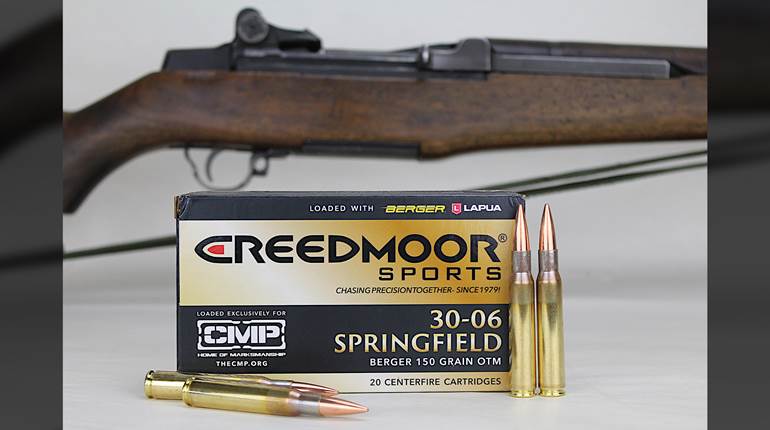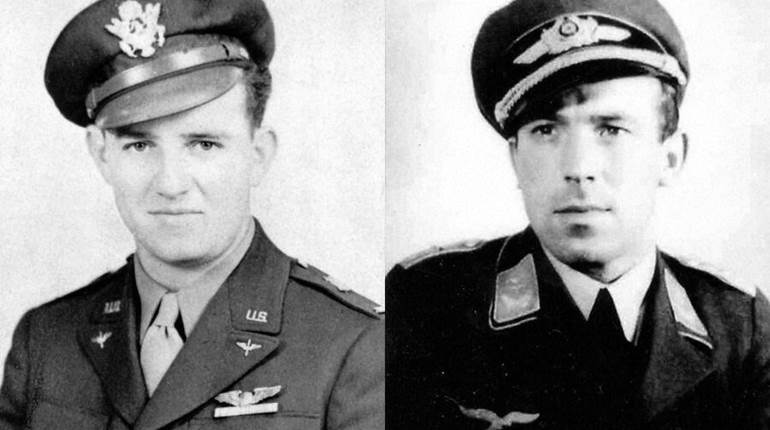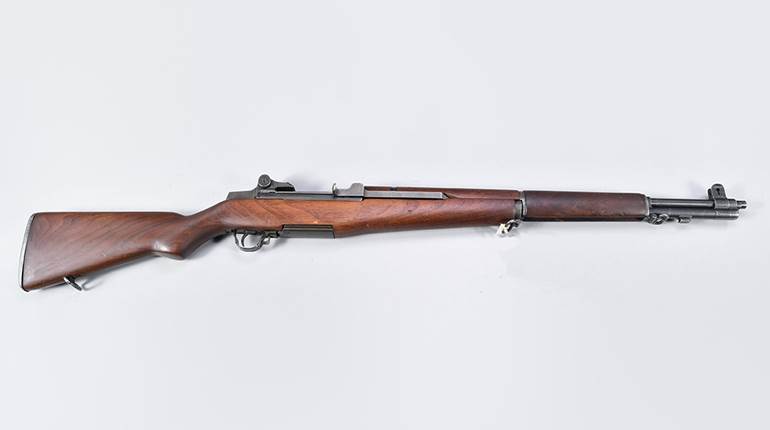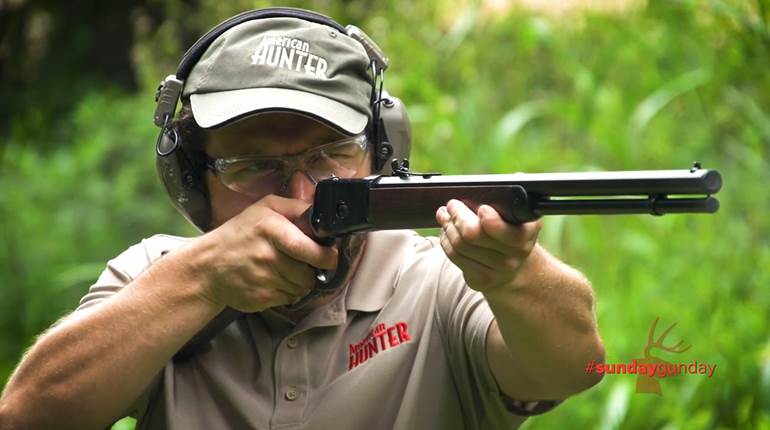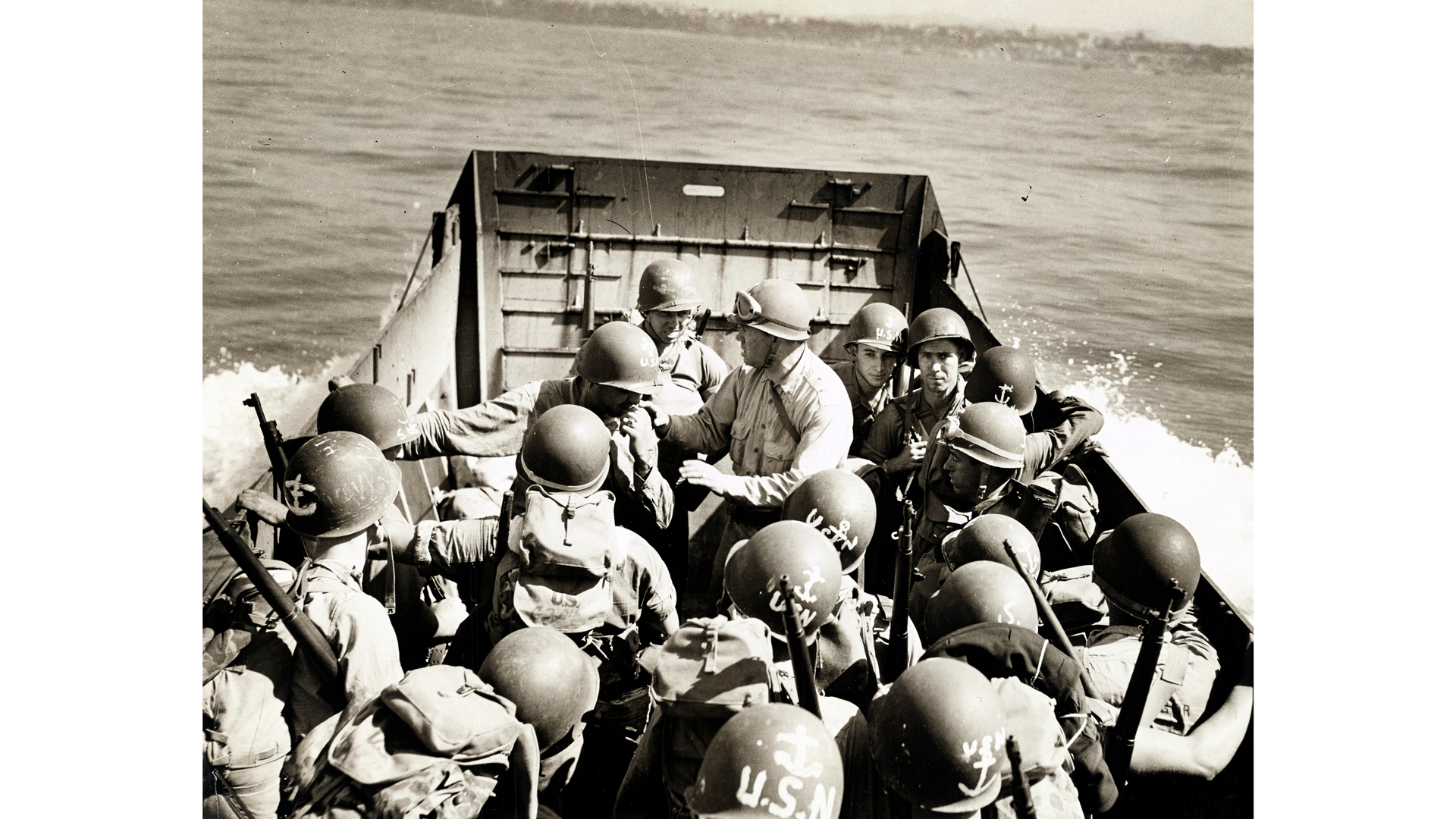
During 1940, the war in North Africa began as a Mediterranean side show. By the time that Rommel’s forces threatened Egypt and the Suez Canal in July 1942, the desert war had become a crisis. The British victory at El Alamein, and the Anglo-American landings in Algeria a few months later, put an ever-tightening squeeze on the Afrika Korps.
 In the North African dust, this member of the 82nd Airborne Division, shown above with the M1 Garand rifle, is ready for the paratroop assault on Sicily. Image courtesy of National Archives.
In the North African dust, this member of the 82nd Airborne Division, shown above with the M1 Garand rifle, is ready for the paratroop assault on Sicily. Image courtesy of National Archives.
When Axis forces in North Africa were forced to surrender during May 1943, the path to an Allied invasion of occupied Europe was clear—Italy was the target. The western Allies could fulfill their promise to Stalin and the Soviets that a true invasion of Axis Europe was in the making. Winston Churchill is noted to have initially described Italy as “the soft underbelly of Europe.” U.S. 5th Army commander General Mark Clark later described Italy as a “tough old gut.” Whatever the description, the stepping stone to Italy was Sicily. Strangely, the Germans didn’t quite believe it.
A Serving Of Mincemeat
Even though Sicily was clearly the most accessible landmass for the Allies to invade, British intelligence successfully convinced the Germans, including Hitler himself, that any attack on Sicily was merely a feint. “Operation Mincemeat” cleverly misled the Germans into believing that Greece and Sardinia were the focus of the upcoming Allied attacks—and reinforcements were sent anywhere in the Mediterranean area but Sicily. “Mincemeat” was also one of the reasons why Hitler cut short the massive Kursk offensive on the Russian front, in order to make troops available to counter an Allied invasion in the Balkans. Meanwhile, there was significant distrust growing between Germany and Italy, and Hitler was loath to rely on Italian troops, even in the defense of their own home territory.
 The first parachute assault of the 82nd Airborne Division came on July 9, 1943, over Sicily. The standing paratrooper carries an early M1A1 carbine with a folding stock. Image courtesy of National Archives.
The first parachute assault of the 82nd Airborne Division came on July 9, 1943, over Sicily. The standing paratrooper carries an early M1A1 carbine with a folding stock. Image courtesy of National Archives.
Even with many factors in their favor, particularly momentum, Allied troops would be attempting a combination of sophisticated operations to assault enemy territory in Sicily by sea and air. Coordinated beach landings and paratroop assaults would test American and British combined skills like never before.
Maturing American Forces
Before the invasion, dubbed “Operation Husky,” Allied air forces pounded Axis airfields across Sicily, destroying more than 300 German and Italian planes, and leaving just two airstrips operational by the time of the landings. Ammunition dumps and logistic centers were repeatedly bombed, while the coastal defenses were left untouched to leave the enemy guessing about landing beaches. Even with the extensive preparatory bombardment, the Axis troops were still in position—and the Italians would be fighting for their home territory.
 A rare appearance of the .30-cal. M1917 “Enfield” rifle in combat during World War II. This U.S. artilleryman (shown above) takes aim on the streets of a Sicilian town. Image courtesy of National Archives.
A rare appearance of the .30-cal. M1917 “Enfield” rifle in combat during World War II. This U.S. artilleryman (shown above) takes aim on the streets of a Sicilian town. Image courtesy of National Archives.
America’s paratroopers were ready for their first major battle, and airborne landings began after dark on July 9th. Powerful winds conspired to widely scatter the 82nd Airborne Division between Gela and Syracuse. Even so, the All-Americans rallied and attacked enemy strongpoints and cut communications. The paratroopers showed grit and initiative, and the airborne concept quickly showed promise. Specialized firearms for the airborne infantry, including the relatively new M1 carbine, offered a competitive advantage.
 The old and the new: The G.I.s carry a wide range of small arms on Sicily, including an M1 Thompson SMG, an M1903 Springfield rifle, and an M1 Garand rifle. The semi-automatic M1 was still being integrated into combat units in the Mediterranean theater of operations until well into 1944. Image courtesy of National Archives.
The old and the new: The G.I.s carry a wide range of small arms on Sicily, including an M1 Thompson SMG, an M1903 Springfield rifle, and an M1 Garand rifle. The semi-automatic M1 was still being integrated into combat units in the Mediterranean theater of operations until well into 1944. Image courtesy of National Archives.
The seaborne landings featured extensive use of the Landing Craft, Vehicle, Personnel (LCVP or Higgins Boat) and the new DUKW amphibious truck. Both provided stellar performance delivering men and supplies from ship to shore throughout the campaign, and Operation Husky was a powerful learning experience and building block for later amphibious operations in the MTO and ETO.
 Enjoying the sun and surf on a Sicilian beach, these GIs carry a mix of M1 Garand and M1903 Springfield rifles. Image courtesy of author.
Enjoying the sun and surf on a Sicilian beach, these GIs carry a mix of M1 Garand and M1903 Springfield rifles. Image courtesy of author.
But even the best plans don’t survive contact with the enemy, and Operation Husky was no different. Despite hopes to the contrary, several Italian coastal defense units fought well. Italian tanks and infantry attacked the Gela beachhead on July 10th, and again on the 12th. U.S. naval gunfire helped save the day on those occasions, breaking up the Italian assaults with 5" and 6" artillery fire support. At the port of Licata, the U.S. 3rd Infantry Division took the town and then held it against a strong Italian counterattack. Casualties were high, with nearly 100 men killed, but the fresh American troops improvised, adapted and carried on to victory.

New Guns Earn Their Stripes While Some Legends Fade
As U.S. troops took on larger combat roles, American-made arms began to make their presence felt. By the summer of 1943, more American infantrymen in the MTO were carrying the M1 Garand rifle. Photos of the action on Sicily show more of the semi-automatic M1 rifles than they do the older (but still deadly) bolt-action M1903 Springfield rifle. American infantry firepower was steadily growing, as more Browning Automatic Rifles were reaching the troops, along with lighter, air-cooled .30-cal. Browning M1919A4 machine guns.
 Glad to be out of the war, this mixed bag of Italian POWs is guarded by a U.S. Coastguardsman armed with an M1A1 Thompson SMG. Image courtesy of National Archives.
Glad to be out of the war, this mixed bag of Italian POWs is guarded by a U.S. Coastguardsman armed with an M1A1 Thompson SMG. Image courtesy of National Archives.
The invasion of Sicily also saw the first significant use of the M1 carbine (.30 Carbine), mostly in the hands of the 82nd Airborne Division paratroops. Among the Carbines were M1A1 folding stock variants, a firearm specifically designed for paratroops. Also, a small number of the improved Bazooka, the M1A1 (and its more reliable M6A1 rocket) were issued in the Sicilian campaign—giving the G.I.s a measure of infantry anti-tank defense. The M1A1 bazooka was credited with destroying four Panzer IV medium tanks and was even reported to have knocked out one of the vaunted German Tiger I tanks on the streets of Biscari. Even so, the Bazooka had not yet won over all the troops—an after-action report from Sicily reads: “Most of the officers prefer the rifle grenade to the Bazooka as a close-range antitank weapon.”
 Sicilian civilians welcoming U.S. troops during late July 1943. The dusty G.I. carries a classic M1903 Springfield rifle. Image courtesy of National Archives.
Sicilian civilians welcoming U.S. troops during late July 1943. The dusty G.I. carries a classic M1903 Springfield rifle. Image courtesy of National Archives.
American troops were growing more experienced with every action, and the telling effect of U.S. infantry firepower was described in Army’s “Report of Operations” on the Sicilian Campaign:
“The German will invariably counterattack immediately after dawn and is very adept in supporting this with artillery and mortar fire. The infantry starts to attack between 800-1000 yards and comes forward at a continuous fast walk using marching fire or firing from the halt, or from the kneel.
In no case where our infantry utilized the full power of their rifle did the German counterattack get home. In fact, our troops looked forward to the German counterattack as the surest and most effective way of killing Germans.
If the observers from the batteries are in contact, it frequently is possible to stop the counterattack by a combination of percussion and air bursts. Only one case is known where the German, stopped by artillery fire, resumed his attack. Normally, he moves forward until human nature can stand no more and then quits. While going forward he shoots a great deal and makes all the noise he can. However, his small arms fire is of little value.”
 No longer a threat: U.S. troops examine the wreck of Junkers Ju 87 “Stuka” dive bomber, destroyed on Sicily. This aircraft was in Italian service, where the Stuka was called “Picchiatello.” Image courtesy of National Archives.
No longer a threat: U.S. troops examine the wreck of Junkers Ju 87 “Stuka” dive bomber, destroyed on Sicily. This aircraft was in Italian service, where the Stuka was called “Picchiatello.” Image courtesy of National Archives.
As the Allies advanced across Sicily, the spirit of the war was changing. For example, one of the German icons of the Blitzkrieg era was no longer relevant on the battlefield, as a US intelligence report noted:
“The German Ju 87 or “Stuka” dive bomber has served its usefulness, lost its terror, and will probably not be seen in future operations.” G.I.s noticed that the sunny skies above contained fewer Axis planes, and when they appeared, American fighters and AA guns usually drove them off.
 U.S. infantrymen on the north coast of Sicily during August 1943, guarding against a potential counterattack. Image courtesy of author.
U.S. infantrymen on the north coast of Sicily during August 1943, guarding against a potential counterattack. Image courtesy of author.
American morale grew stronger, and General Patton famously raced with British Field Marshal Montgomery to be the first to reach Messina. Along the way, U.S. G-2 provided this assessment of Axis morale on Sicily:
“Morale of the German prisoners interrogated indicates it is low and of a defeatist nature. Morale of the Italian prisoners is apparently higher, while the native population has invariable welcomed the advance of American troops.”
 Preparing for a German counterattack during Patton’s drive to Messina, this machine gunner of the 30th Infantry Regiment scrapes out a hasty firing position for his Browning .30-cal. M1917 water-cooled MG. Image courtesy of National Archives.
Preparing for a German counterattack during Patton’s drive to Messina, this machine gunner of the 30th Infantry Regiment scrapes out a hasty firing position for his Browning .30-cal. M1917 water-cooled MG. Image courtesy of National Archives.
Growing Distrust
As the Allies advanced in Sicily, the Italian government began to lose confidence in Mussolini. On July 24, 1943, the Duce was summoned before the Fascist National Council, where he suffered through a vote of no-confidence. The next day, Mussolini met with King Victor Emmanuel and was dismissed from his position as prime minister. As he left the meeting, Il Duce was arrested, and taken to the first in a series of secret locations. When news of his downfall was broadcast to the Italian people, many celebrated, anticipating the end of the war for Italy. Meanwhile, the Italian army remained intact in the field, loyal to their king.
 A U.S. Coastguardsman proudly displays his war trophy, an Italian Carcano M91 carbine (6.5x52 mm). Image courtesy of National Archives.
A U.S. Coastguardsman proudly displays his war trophy, an Italian Carcano M91 carbine (6.5x52 mm). Image courtesy of National Archives.
From Hitler on down to the lowest ranks of the German military, there was little faith or trust in their Italian allies. On the Italian side, the Germans seemed increasingly like prison guards than they were partners. More and more Italians began to consider Allied troops, particularly Americans, as more friend than foe.
Excerpts from orders captured from the Herman Goering Division in early August 1943, provide some insight into the growing Axis rift, and the declining tactical situation:
Instructions for further fighting in Sicily:
-No roadblocks or demolitions will be manned by Italians.
-No Italians will be allowed to disturb troop movements, either civilians or soldiers. Every Italian and all Italian equipment is to be cleared from the streets (except those Italians who have been fighting and who will still fight).
-Destroy all materials which cannot be carried. Burning material is forbidden on account of hostile aircraft. The best procedure is to blow up the material.
The final command on the list is the most telling, as well as the most sinister:
The strictest discipline must govern. Shoot all who fail to obey.
America’s Fighting Men Coming Of Age
Taking advantage of an extremely heavy concentration of anti-aircraft guns on the narrow strait of Messina, Axis forces began a general evacuation from Sicily, beginning on August 11th. By August 18th, the Italians had removed more than 60,000 men to the mainland, while the Germans evacuated more than 50,000, along with 47 tanks. But while the Germans could briefly celebrate saving valuable men and equipment, they still suffered more than 4,000 dead, and about 10,000 captured. Worse still, they were soon to lose Italy as an ally.
 The massive German Pzkw VI Tiger I, knocked out on the streets of Biscari, Sicily. Sixteen of these 60-ton tanks were lost during the campaign on Sicily. Image courtesy of National Archives.
The massive German Pzkw VI Tiger I, knocked out on the streets of Biscari, Sicily. Sixteen of these 60-ton tanks were lost during the campaign on Sicily. Image courtesy of National Archives.
With Mussolini imprisoned, and more than 116,000 of their soldiers captured on Sicily, Italy was on the brink of collapse. Sicily fell on August 17th, and the Italian surrender soon followed. Fascist Italy came to an end on Sept. 3, 1943, with the signing of the Armistice of Cassibile. In early 1944, the Italian co-belligerent army was formed, fighting alongside the Allies until the end of the war.
U.S. forces suffered nearly 10,000 casualties during the campaign in Sicily. It was a steep price to pay for the hard-knocks education of a new global fighting force. But Sicily was taken, and Italy was knocked out. The door to the initial invasion of Europe was open. The U.S. 7th Army report on the battle of Messina concluded:
“The fall of Messina was the fall of Sicily itself. Thirty-eight days after the landings, the campaign had ended. The first United States field army to fight as a unit in this war had accomplished its mission with complete success. Long hard months of training and of battle experience, the vast productive power of America, and the courage and vision of its leaders had combined to demonstrate to the world that the unprepared nation of two years before had arrived on the scene of battle as a full-fledged fighting power.”













